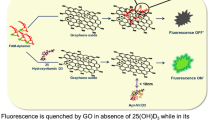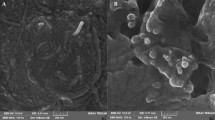Abstract
Vitamin D3 (VD3) is the main form of vitamin D and an essential nutrient for maintaining human life. Currently, traditional methods for detecting 25-hydroxyvitamin D3(25(OH)D3) are complex and expensive. In this study, we constructed an accurate, sensitive, simple, and cost-effective label-free biosensor based on an aptamer for the detection of 25(OH)D3. The aptamer-modified sulfhydryl adopted self-assembly as a way to stably immobilize at the glassy carbon electrode (GCE) surface modified by gold nanoparticles (AuNPs). Upon 25(OH)D3 binding to the aptamer, the complexes inhibit electron transfer at the electrode surface, leading to reduced [Fe(CN)6]3−/4− redox peak current. Consequently, the quantity of 25(OH)D3 that interacts with the electrode-bound aptamer correlates with the observed electric current response values. The Aptamer/AuNPs/GCE aptasensor achieved direct and highly sensitive detection of 25(OH)D3 over a wide concentration range (1.0–1000 nM), with a limit of detection of 1.0 nM. At the same time, other molecules with a similar structure, such as 25(OH)D2, Vitamin D3, and Vitamin D2, had lower response interference than 25(OH)D3. Therefore, this biosensor has great potential to become a portable diagnostic device for 25(OH)D3.
Graphic abstract







Similar content being viewed by others
Data availability
The authors confirm that the data supporting the findings of this study are available within the article.
References
S.S. Pukale, A. Mittal, D. Chitkara, Topical application of vitamin D3-loaded hybrid nanosystem to offset imiquimod-induced psoriasis. AAPS PharmSciTech 22(7), 238 (2021)
R. Gupta, S. Kaul, V. Singh et al., Graphene oxide and fluorescent aptamer based novel biosensor for detection of 25-hydroxyvitamin D3. Sci. Rep. 11(1), 23456 (2021)
M.T. Munir, C. Ponce, J.M. Santos et al., VD3 and LXR agonist (T0901317) combination demonstrated greater potency in inhibiting cholesterol accumulation and inducing apoptosis via ABCA1-CHOP-BCL-2 cascade in MCF-7 breast cancer cells. Mol. Biol. Rep. 47(10), 7771–7782 (2020)
Y.A. Dulla, Y. Kurauchi, A. Hisatsune et al., Regulatory mechanisms of vitamin D3 on production of nitric oxide and pro-inflammatory cytokines in microglial BV-2 Cells. Neurochem. Res.. Res. 41(11), 2848–2858 (2016)
B.W. Hollis, J.Q. Kamerud, S.R. Selvaag et al., Determination of vitamin D status by radioimmunoassay with an 125I-labeled tracer. Clin. Chem.. Chem. 39(3), 529–533 (1993)
D. Wagner, H.E. Hanwell, R. Vieth, An evaluation of automated methods for measurement of serum 25-hydroxyvitamin D. Clin. Biochem.. Biochem. 42(15), 1549–1556 (2009)
G. Lazzarino, S. Longo, A.M. Amorini et al., Single-step preparation of selected biological fluids for the high performance liquid chromatographic analysis of fat-soluble vitamins and antioxidants. J. Chromatogr. AChromatogr. A 1527, 43–52 (2017)
J. Zhou, F. Wang, Y. Ma et al., Vitamin D3 contributes to enhanced osteogenic differentiation of MSCs under oxidative stress condition via activating the endogenous antioxidant system. Osteoporos Int. Int. 29(8), 1917–1926 (2018)
L. Maghsoumi-Norouzabad, A. ZareJavid, A. Mansoori et al., Vitamin D3 supplementation effects on spermatogram and oxidative stress biomarkers in asthenozoospermia infertile men: a randomized, triple-blind, placebo-controlled clinical trial. Reprod. Sci.. Sci. 29(3), 823–835 (2022)
J.H. Lee, J.H. Choi, O.J. Kweon et al., Discrepancy between Vitamin D total immunoassays due to various cross-reactivities. J Bone Metab 22(3), 107–112 (2015)
Y. Zhang, N. Li, Y. Xu et al., An ultrasensitive dual-signal aptasensor based on functionalized Sb@ZIF-67 nanocomposites for simultaneously detect multiple biomarkers. Biosens. Bioelectron.. Bioelectron. 214, 114508 (2022)
Z. Hua, T. Yu, D. Liu et al., Recent advances in gold nanoparticles-based biosensors for food safety detection. Biosens. Bioelectron.. Bioelectron. 179, 113076 (2021)
L.C. Bock, L.C. Griffin, J.A. Latham et al., Selection of single-stranded DNA molecules that bind and inhibit human thrombin [J]. Nature 355(6360), 564–566 (1992)
A.D. Ellington, J.W. Szostak, In vitro selection of RNA molecules that bind specific ligands. Nature 346(6287), 818–822 (1990)
C. Tuerk, L. Gold, Systematic evolution of ligands by exponential enrichment: RNA ligands to bacteriophage T4 DNA polymerase. Science 249(4968), 505–510 (1990)
S. Nooranian, A. Mohammadinejad, T. Mohajeri et al., Biosensors based on aptamer-conjugated gold nanoparticles: a review. Biotechnol. Appl. Biochem.. Appl. Biochem. 69(4), 1517–1534 (2022)
Y. Zhang, B.S. Lai, M. Juhas, Recent advances in aptamer discovery and applications. Molecules 24(5), 941 (2019)
G. Marrazza, Aptamer sensors. Biosensors (Basel) 7(1), 5 (2017)
Z. Li, M.A. Mohamed, A.M. Vinu Mohan et al., Application of electrochemical aptasensors toward clinical diagnostics, food, and environmental monitoring: review. Sensors (Basel) 19(24), 5435 (2019)
T. Bystron, E. Sramkova, F. Dvorak et al., Glassy carbon electrode activation – a way towards highly active, reproducible and stable electrode surface. Electrochim. Acta. Acta 299, 963–970 (2019)
D.D. Markushev, J. Ordonez-Miranda, M.D. Rabasović et al., Thermal and elastic characterization of glassy carbon thin films by photoacoustic measurements. Eur. Phys J. Plus (2017). https://doi.org/10.1140/epjp/i2017-11307-2
A. Kulpa-Koterwa, T. Ossowski, P. Niedzialkowski, Functionalized Fe(3)O(4) nanoparticles as glassy carbon electrode modifiers for heavy metal ions detection-a mini review. Materials (Basel) 14(24), 7725 (2021)
E.H. Jeong, G. Jung, C.A. Hong et al., Gold nanoparticle (AuNP)-based drug delivery and molecular imaging for biomedical applications. Arch. Pharm. Res. 37(1), 53–59 (2014)
E. Boisselier, D. Astruc, Gold nanoparticles in nanomedicine: preparations, imaging, diagnostics, therapies and toxicity. Chem. Soc. Rev. 38(6), 1759–1782 (2009)
P. Singh, S.K. Pandey, J. Singh et al., Biomedical perspective of electrochemical nanobiosensor. Nanomicro Lett. 8(3), 193–203 (2016)
G. Aragay, A. Merkoçi, Nanomaterials application in electrochemical detection of heavy metals. Electrochim. Acta. Acta 84, 49–61 (2012)
C.W. Kuo, S.H. Wang, S.C. Lo et al., Sensitive oligonucleotide detection using resonant coupling between fano resonance and image dipoles of gold nanoparticles. ACS Appl. Mater. Interfaces 14(12), 14012–14024 (2022)
X. Zhang, Gold nanoparticles: recent advances in the biomedical applications. Cell Biochem. Biophys.Biochem. Biophys. 72(3), 771–775 (2015)
B.H. Lee, V.T. Nguyen, M.B. Gu, Highly sensitive detection of 25-HydroxyvitaminD3 by using a target-induced displacement of aptamer. Biosens. Bioelectron.. Bioelectron. 88, 174–180 (2017)
M. Popenda, M. Szachniuk, M. Antczak et al., Automated 3D structure composition for large RNAs. Nucleic Acids Res. 40(14), e112 (2012)
R.F. Brocenschi, P. Hammer, C. Deslouis et al., Assessments of the effect of increasingly severe cathodic pretreatments on the electrochemical activity of polycrystalline boron-doped diamond electrodes. Anal. Chem. 88(10), 5363–5368 (2016)
M. Tolba, M.U. Ahmed, C. Tlili et al., A bacteriophage endolysin-based electrochemical impedance biosensor for the rapid detection of Listeria cells. Analyst 137(24), 5749–5756 (2012)
S. Wadhwa, A.T. John, S. Nagabooshanam et al., Graphene quantum dot-gold hybrid nanoparticles integrated aptasensor for ultra-sensitive detection of vitamin D3 towards point-of-care application. Appl. Surface Sci. 521, 146427 (2020)
D.J. Patel, A.K. Suri, Structure, recognition and discrimination in RNA aptamer complexes with cofactors, amino acids, drugs and aminoglycoside antibiotics. J. Biotechnol.Biotechnol. 74(1), 39–60 (2000)
D.H. Bunka, P.G. Stockley, Aptamers come of age - at last. Nat. Rev. Microbiol.Microbiol. 4(8), 588–596 (2006)
H. Ye, Y. Zhou, P. Ma et al., Analysis of the anti-inflammatory effect of the aptamer LA27 and its binding mechanism. Int. J. Biol. Macromol.Macromol. 165(Pt A), 308–313 (2020)
M. Prante, T. Schuling, B. Roth et al., Characterization of an aptamer directed against 25-hydroxyvitamin D for the development of a competitive aptamer-based assay. Biosensors (Basel) 9(4), 134 (2019)
S. Vemulapati, E. Rey, D. O’Dell et al., A quantitative point-of-need assay for the assessment of vitamin D(3) deficiency. Sci. Rep. 7(1), 14142 (2017)
S. Jo, W. Lee, J. Park et al., Wide-range direct detection of 25-hydroxyvitamin D(3) using polyethylene-glycol-free gold nanorod based on LSPR aptasensor. Biosens. Bioelectron.. Bioelectron. 181, 113118 (2021)
S. Yin, M.N. Hossain, Y. Li et al., Development of a novel electrochemical aptasensor based on catalytic hairpin assembly and DNA tetrahedron for the detection of 25-hydroxyvitamin D3. Sens. Actuators B: Chem. 354, 13217 (2022)
D. Chauhan, P.R. Solanki, Hydrophilic and Insoluble electrospun cellulose acetate fiber-based biosensing platform for 25-hydroxy vitamin-D3 detection. ACS Appl. Polym. Mater. 1(7), 1613–1623 (2019)
L. Carlucci, G. Favero, C. Tortolini et al., Several approaches for vitamin D determination by surface plasmon resonance and electrochemical affinity biosensors. Biosens. Bioelectron.. Bioelectron. 40(1), 350–355 (2013)
A. Giustina, R.A. Adler, N. Binkley et al., Consensus statement from 2(nd) international conference on controversies in vitamin D. Rev. Endocr. Metab. Disord.Endocr. Metab. Disord. 21(1), 89–116 (2020)
Acknowledgements
This work was supported by the Graduate school-enterprise joint innovation Project of Central South University (No. 2022XQLH074, 2022XQLH075, and 2022XQLH076) and the Natural Science Foundation of Hunan Province (No. 2022JJ80105).
Funding
Innovation-Driven Project of Central South University, 2022XQLH074, Zheng Wei, 2022XQLH075, Meilun Chen,2022XQLH076, Xiaoling Lu, Natural Science Foundation of Hunan Province, 2022JJ80105, Peng Yu.
Author information
Authors and Affiliations
Contributions
TC designed and guided the project. MC wrote the manuscript. XL developed the method of electrodeposition. ZW made electrodes. CT and JY characterized the aptamer. YH assisted in revising the manuscript. JZ provided methodological advice. PY provided financial support.
Corresponding author
Ethics declarations
Conflict of interest
The authors declare no competing interests.
Rights and permissions
Springer Nature or its licensor (e.g. a society or other partner) holds exclusive rights to this article under a publishing agreement with the author(s) or other rightsholder(s); author self-archiving of the accepted manuscript version of this article is solely governed by the terms of such publishing agreement and applicable law.
About this article
Cite this article
Cai, T., Chen, M., Yang, J. et al. An AuNPs-based electrochemical aptasensor for the detection of 25-hydroxy vitamin D3. ANAL. SCI. 40, 599–607 (2024). https://doi.org/10.1007/s44211-023-00489-0
Received:
Accepted:
Published:
Issue Date:
DOI: https://doi.org/10.1007/s44211-023-00489-0




